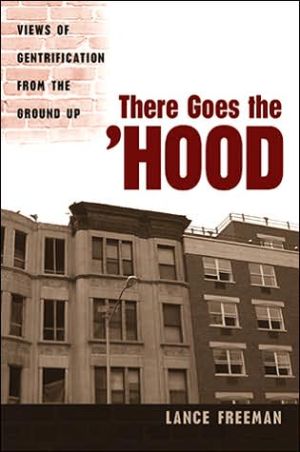

 |

|

The average rating for There Goes the Hood: Views of Gentrification from the Ground Up based on 2 reviews is 4 stars.
Review # 1 was written on 2015-05-27 00:00:00 Justin Zucchiatti Justin ZucchiattiSince I've been contemplating urban planning as a profession, I decided I should research gentrification. After all, gentrification could be a harm urban planners cause, however indirectly, in their work. Author Lance Freeman is a professor of urban planning at Columbia University and moreover is black and lives in Clinton Hill. Freeman lays out the goal of more fully considering the perspectives of the poor residents of gentrifying ghettoes since they are frequently regarded as victims soon to be displaced but seldom even asked for their opinion or considered as agents of change in their own neighborhood. I really like Chapter 2 which sketches the history of Clinton Hill and Harlem. Harlem is fascinating in that it became a predominantly black neighborhood partially by accident after a speculative real estate bubble burst and rentiers found they could only rent out their units if they loosened their discriminatory practices and open their buildings to black renters. Of course, whites later tried to take back their hoity-toity development in 1904 by evicting blacks, but blacks organized and black realtor Phillip Payton Jr. bought up many buildings to protect their status in the neighborhood and evict whites to retaliate. So, as Freeman said: "Thus it came to be that African Americans occupied one of the choicest sections of New York City." The history was truly illuminating and perhaps it's telling and a bit amusing that Harlem, the Capital of Black America developed not by government action but by blacks taking advantage of the slightest of openings presented by a series of failed real estate speculations by white developers. In other words, whites helped blacks more by mistake than they did on purpose. Red-lining and other forms of economic discrimination ended up reversing Harlem's fortunes in the postwar period and the neighborhood was ravaged with drug violence and arson and partly abandoned. Establishing the base of history, Freeman delved into the qualitative interviews he conducted with long time residents of Harlem and Clinton Hill. He did see the backlash and resentment toward gentrification in his interviews, but there was also appreciation for the greater amenities gentrification brings and occasionally for a hope for a more heterogenous neighborhood. Among interviewees there was much anxiety about displacement but not many people had actually been displaced... yet. Partially, that poor residents could weather the tide of gentrification was particular to New York City advanced affordable housing policies including rent regulation and housing co-ops where poor residents are allowed to buy their apartment rather than just rent. Seattle does not have such advanced and progressive practices and has seen many blacks displaced from its historically black neighborhood, Central District, to the point less than 20 percent of the neighborhood is now black. Consequently, it might not be possible to generalize the resiliency of New York City's black neighborhoods to the rest of the country. But Freeman's prescription for maintaining affordable housing in gentrifying neighborhoods should help harness the potential of gentrification. Tax Increment Financing would divert the gain in property tax revenues to building more affordable housing. Inclusionary zoning, which require new housing developments to set aside a portion of units to be affordable to moderate income households, would also help. |
Review # 2 was written on 2013-02-04 00:00:00 George Lawrence George LawrenceThis was an assigned text for a class I took on urban education, and takes a close look at gentrification in two NYC neighborhoods, Harlem and Clinton Hill. I currently live in the latter, and it certainly was unsettling to see my apartment (and the coffee shop across the street) not only mentioned as an example of neighborhood change, but pictured! But, one of Freeman's central arguments is that gentrification is not either all negative or all positive--some changes can be good for all residents, both new and "indigenous," such as increased amenities and police protection, while other changes can be bad, as is the case when indigenous residents are priced out. Freeman does a nice job of incorporating into his analysis perspectives from many different kinds of residents in both neighborhoods. On the whole, this is a worthwhile book for anyone who interested in urban spaces and renewal, and in the policies that shape who lives where. |
CAN'T FIND WHAT YOU'RE LOOKING FOR? CLICK HERE!!!